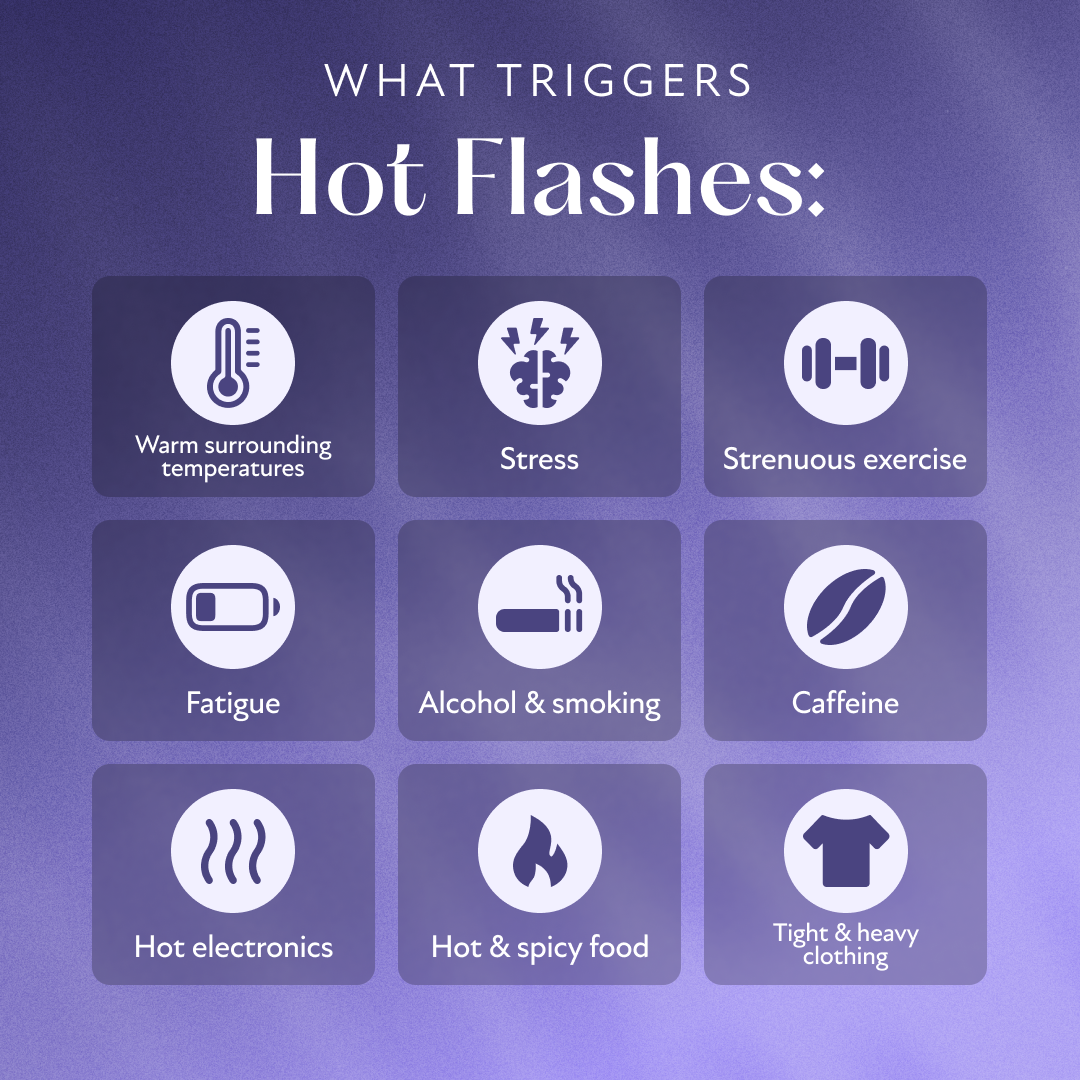Hot flashes affect almost 80% of women during their transition through menopause, presenting a variety of symptoms that vary in severity for each woman.1 Despite being a common occurrence, hot flashes are rarely discussed openly, leaving many women with doubts about what to expect and the available treatment options. This page aims to address the most pressing questions about hot flashes to provide clarity and support.
It's important to recognize that while many women manage mild menopause symptoms, those experiencing severe hot flashes should not suffer in silence. Fortunately, effective treatment options are available. By seeking professional help, women can find the relief they deserve.
What is a hot flash during menopause?
Hot flashes during menopause are sudden episodes of warmth, primarily affecting the chest, neck, and face. These sensations, often intense and episodic, are linked to changing hormonal levels in the body. Typically, a hot flash is immediately followed by sweating as the body attempts to cool down.2
When do hot flashes start?
Although most women develop hot flashes during perimenopause and early postmenopause, some experience them while their menstrual cycles remain regular. Here's what women can expect:3
40s: Most women start perimenopause and begin having hot flashes and night sweats. Some may start experiencing them in their 30s.
Ages 46-53: This is the average age for menopause in the U.S., defined as 12 months without a period. Hot flashes peak in the two years after menopause.
Late 50s: Hot flashes often continue for four to ten years post-menopause but usually decrease in frequency and severity.
Hot Flash Symptoms During Menopause
Hot flashes, a vasomotor symptom, usually last one to five minutes and cause the following sensations: 2,4
A sudden rush of warmth usually affecting the face, chest, or neck
Flushed and red skin
Shivering and/or chills
Perspiration (especially on the upper body)
Feelings of anxiety
Rapid or irregular heartbeats
When vasomotor symptoms predominantly occur at night, they are known as night sweats. These nighttime episodes can disrupt sleep, leaving women exhausted the next day.
Causes of Hot Flashes During Menopause
Experts aren't sure what exactly causes hot flashes, but they suspect that changing hormone levels affect the hypothalamus, the part of the brain that regulates body temperature.5
When the hypothalamus senses warmth, it prompts blood vessels to widen, increasing blood flow to the skin’s surface. This process causes intense heat sensations and can lead to heavy sweating as the body tries to cool down.
Common triggers include the following:6,7
Stress
Hot weather
Smoking
Tight clothing
Caffeine
Spicy foods
Alcohol
Heat

Treatments for Menopause Hot Flashes
There are various ways to manage hot flashes, with treatment options tailored to their severity and frequency. From lifestyle changes to medical interventions, women can find effective strategies to alleviate their symptoms.
Hormone Replacement Therapy (HRT)
Systemic estrogen is the most effective menopause treatment for hot flashes and may reduce their frequency by 75%.2 Women with an intact uterus are recommended progesterone alongside estrogen to prevent endometrial hyperplasia and carcinoma.
Hormone therapy (HT) comes in various forms, including oral, parenteral, topical, transbuccal, vaginal, and transdermal, with each route offering different formulations and doses of estrogen and/or progesterone.
It’s important to know not all hormone replacement therapies are the same. Bioidentical hormones, unlike synthetic ones, have the same molecular structure as the body's natural hormones, allowing them to mimic natural hormone functions more closely. This also allows them to be better tolerated by most patients.
Non-Hormonal Medications
These are some of the commonly recommended non-hormonal options:
SSRIs/SNRIs: Selective serotonin reuptake inhibitors (SSRIs) and serotonin and norepinephrine reuptake inhibitors (SNRIs) are antidepressants that can be especially helpful for women experiencing mood or anxiety symptoms along with night sweats. Studies have shown that certain antidepressants are effective in treating hot flashes. For instance, Paroxetine, an SSRI, reduced hot flash scores by 62% (12.5 mg/day) and 65% (25.0 mg/day) in a study of 165 women experiencing two to three hot flashes per day, compared to a 37.8% reduction with placebo.8
Fezolinetant: This medication works by blocking neurokinin B in the brain, which helps reduce the brain's signals that trigger hot flashes and night sweats. In a 12-week study, women taking fezolinetant experienced 63% fewer hot flashes compared to 42% in the placebo group.9
Clonidine: This medication reduces hot flashes by expanding the thermoneutral zone — the range of temperatures where the body can keep its core temperature stable just by losing heat. Two small, placebo-controlled studies found that oral clonidine reduced hot flash frequency by 46%, while transdermal clonidine achieved an 80% reduction.8
Over-the-Counter (OTC) Therapies
Many women prefer herbal and over-the-counter therapies to manage their symptoms. However, botanicals and herbs may have side effects or interact with other medications. So, it's important to consult a physician before adding new supplements to the regimen. Here are some commonly used supplements:10,13
Black cohosh: This is traditionally believed to alleviate hot flashes and other menopausal symptoms.
Evening primrose oil: This is thought to ease menopausal symptoms due to its fatty acid content.
Dong quai: Often promoted for women's health, dong quai does lack substantial clinical evidence to support this.
Soy and soy products: Containing isoflavones, soy is included in foods and supplements for its estrogen-like effects.
Flaxseeds: These are known for their estrogenic properties thanks to their high lignan content.
Red clover: Rich in isoflavones similar to soy, red clover is a popular choice for supplementation.
What stops hot flashes naturally?
To help hot flashes naturally, these lifestyle modifications can be a great starting point:2
Exercise:
Engaging in regular, moderate-intensity physical activity, such as aerobic exercises, like brisk walking or swimming, may help reduce hot flashes. Resistance exercises like weight lifting can also be beneficial. Women can benefit from including both types of activities in their routines to maximize the advantages of regular, moderate exercise.14
Yoga:
Yoga combines physical postures, breathing exercises, and meditation, which may help reduce stress and promote relaxation. This holistic approach can alleviate the intensity and frequency of hot flashes.15
Relaxation Techniques:
Slow-breathing exercises and other relaxation techniques can reduce the frequency and severity of hot flashes. These methods help by lowering stress and promoting a sense of calm.
Additional Lifestyle Modifications:
Dress in layers that are easily removed when needed.
Stay away from spicy foods, alcohol, caffeine, and hot beverages.
Sit still in a cool room whenever possible.
Try to maintain a healthy body weight, especially for those with obesity.
Quitting smoking and tobacco use can help, as smoking increases the risk of more frequent and severe hot flashes, along with other cardiovascular risks.
Can hormone replacement therapy help hot flashes during menopause?
During the menopausal transition, the ovaries produce less estrogen and progesterone, leading to hot flashes and other menopausal symptoms.
Hormone therapy stabilizes estrogen and progesterone levels in the body. It’s a highly effective and gold-standard treatment for hot flashes in women who are safe candidates. Hormone therapy also helps with vaginal dryness, improves sleep, and maintains bone density.
Experiencing menopausal hot flashes? Discover if HRT is right for you.
If you’ve entered the menopause transition and are struggling with hot flashes, you don’t have to suffer in silence. Take our brief menopause quiz to see if you’re an eligible candidate for HRT. Get started with Winona to take the first step toward feeling better.
